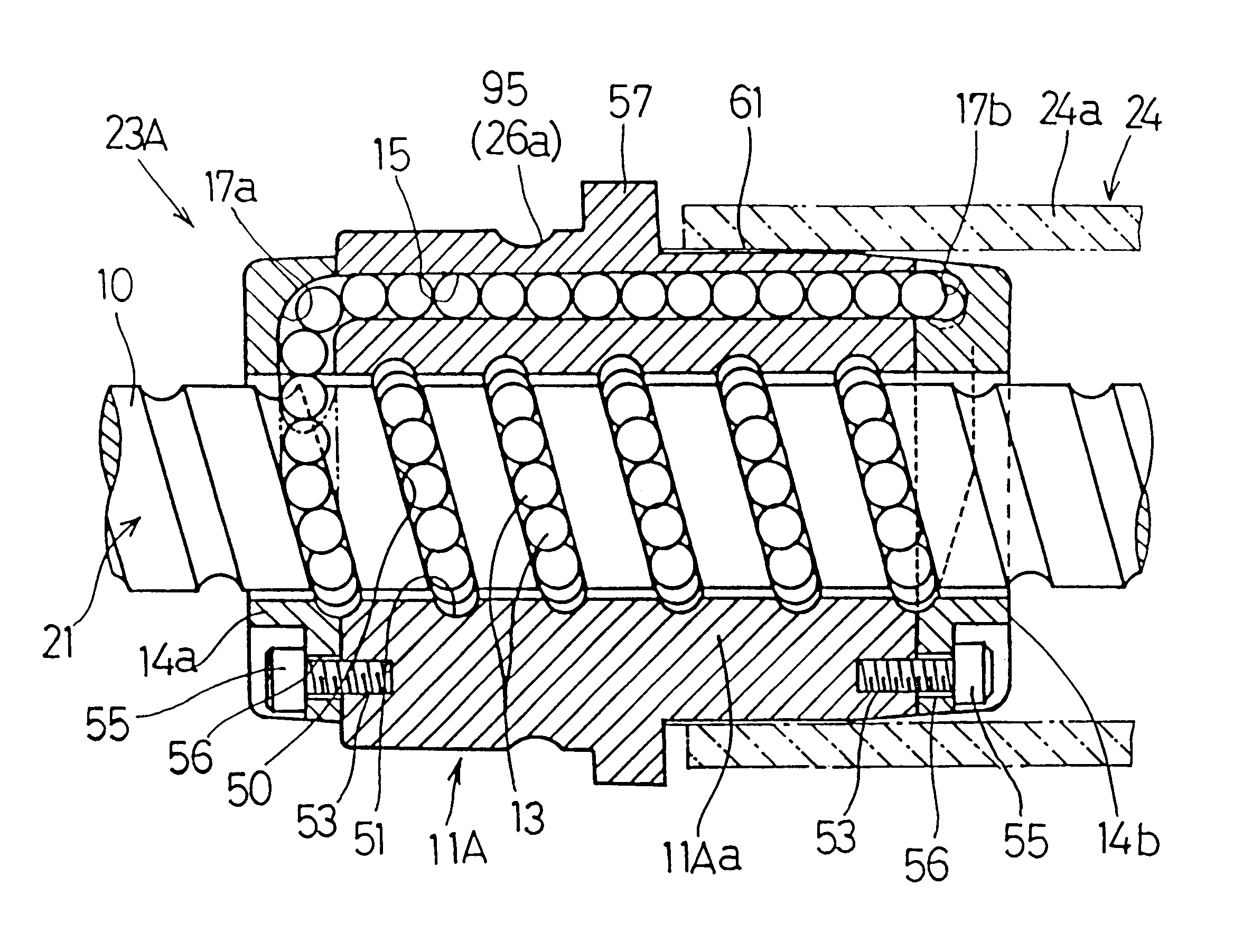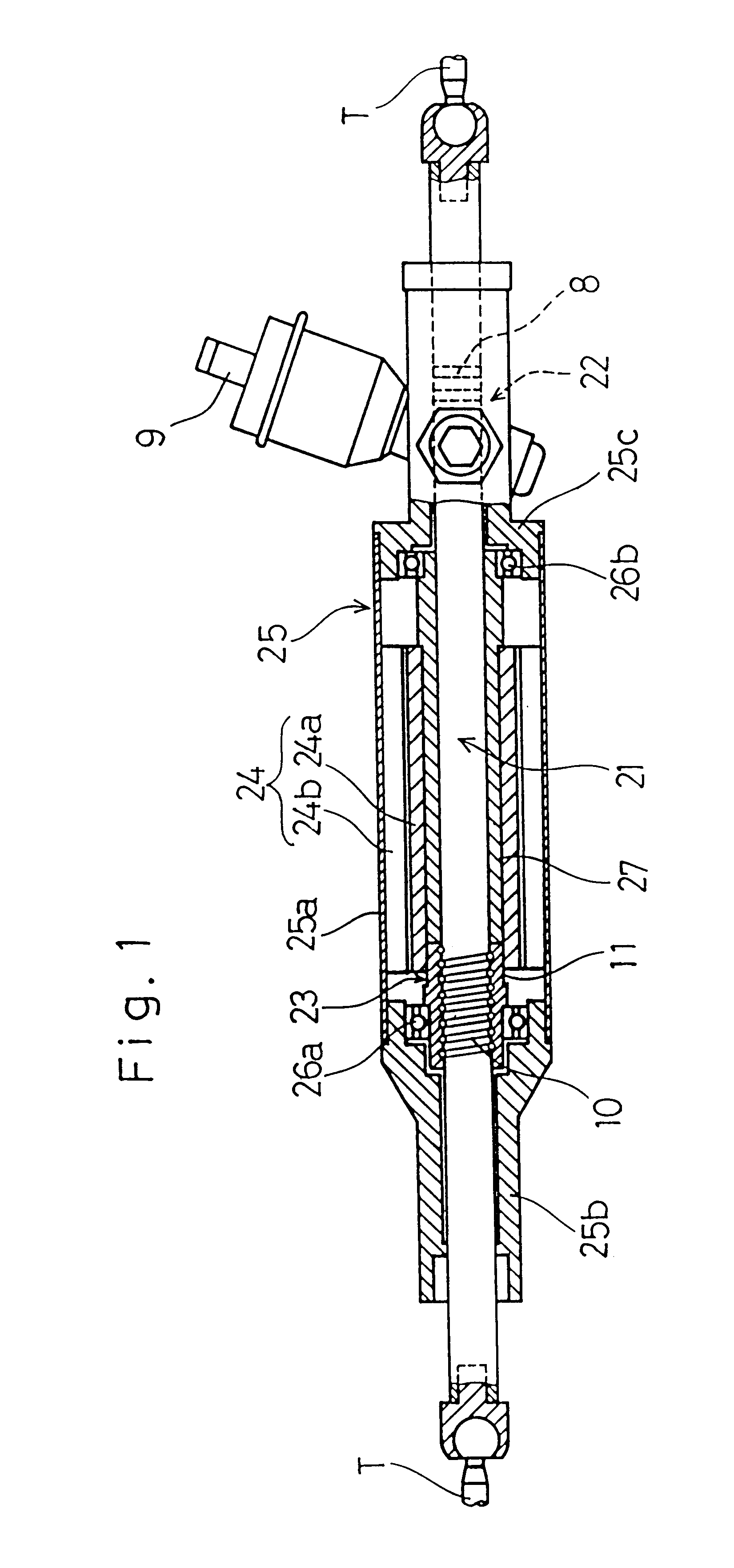Electrically powered steering device
a steering device and electric technology, applied in the direction of gearing, servomotors, transportation and packaging, etc., can solve the problems of impracticality, inability, interference with the inner diameter of the rotor,
- Summary
- Abstract
- Description
- Claims
- Application Information
AI Technical Summary
Problems solved by technology
Method used
Image
Examples
third embodiment
This electrically powered steering device according to the third preferred embodiment is substantially similar to that according to the first preferred embodiment except that the ball screw mechanism 23B different from the ball screw mechanism 23 is employed. Specifically, in the ball screw mechanism 23B employed in the present invention, the end cap 14a is dispensed with.
The ball screw mechanism 23B will now be described with particular reference to FIGS. 11 to 14. The illustrated ball screw mechanism 23B includes the ball screw shaft 10, the rotary nut 10B and the group of the balls 13 interposed between the ball screw shaft 10 and the rotary nut 11B.
The ball screw mechanism 23B is of a type wherein one of the end caps is formed integrally with the nut body and is hence an integral part of the rotary nut. Specifically, the rotary nut 11B includes the nut body 11Ba and the end cap 14b firmly connected to one end of the nut body 11Ba. The end cap 14b is in the form of a ring having ...
second embodiment
It is to be noted that as is the case with the present invention, the inner race raceway for the rolling bearing 26a can be formed integrally on the outer peripheral surface of the rotary nut 11B of the ball screw mechanism 23B.
The electrically powered steering device according to a fourth preferred embodiment of the present invention employs the ball screw mechanism that is substantially similar to that according to any one of the first to third embodiment of the present invention, except that the ball screw mechanism employed in the practice of the fourth embodiment of the present invention includes a plurality of ball circulating passages and the tapered surface on the outer peripheral surface of the end of the rotary nut is dispensed with.
fourth embodiment
Referring to FIG. 15, there is shown a schematic sectional view of the ball screw mechanism employed in the practice of the fourth preferred embodiment of the present invention. As shown therein, the ball screw mechanism 23C includes the ball screw shaft 10 having the spiral outer groove 50 formed on the outer peripheral surface thereof in the form of a multi-threaded groove (for example, double-threaded groove as shown in FIG. 15), the rotary nut 11C having the spiral inner groove 51 formed on the inner peripheral surface thereof in the form of a correspondingly multi-threaded groove, and the group of the torque transmitting balls 13 disposed in series with each other in the ball rolling guideway 12 defined between the spiral outer and inner grooves 50 and 51. As shown in FIG. 15, the balls 13 are turned in a grooved reversing guideway 17a, defined in the end cap 14a at, for example, a left end of the nut body 11Ca as viewed in FIG. 15, so as to travel into a circulating tunnel 15C...
PUM
 Login to View More
Login to View More Abstract
Description
Claims
Application Information
 Login to View More
Login to View More - R&D
- Intellectual Property
- Life Sciences
- Materials
- Tech Scout
- Unparalleled Data Quality
- Higher Quality Content
- 60% Fewer Hallucinations
Browse by: Latest US Patents, China's latest patents, Technical Efficacy Thesaurus, Application Domain, Technology Topic, Popular Technical Reports.
© 2025 PatSnap. All rights reserved.Legal|Privacy policy|Modern Slavery Act Transparency Statement|Sitemap|About US| Contact US: help@patsnap.com



